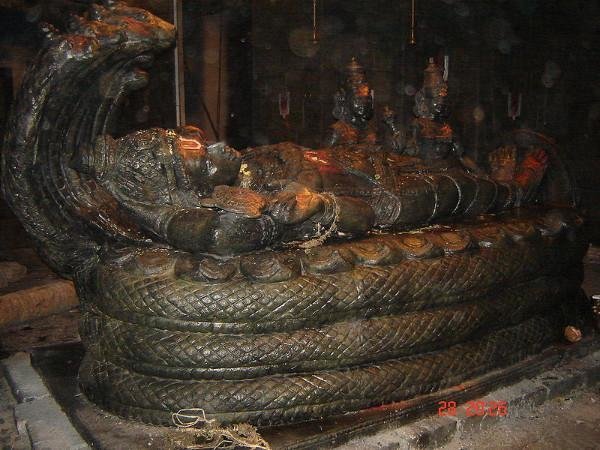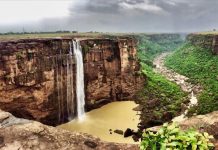What is the secret behind the last door in the Anantha Padmanabhaswamy temple?
Anantha Padmanabhaswamy temple although has been existing since centuries, it came to lime light only in the year 2011, when the Supreme Court ordered the opening the 6 secret chambers in the temple.

Anantha Padmanabhaswamy temple is located in Thiruvananthapuram. The temple is a replica of the Adikesava Perumal temple located in Kanyakumari District. It is one of the richest Hindu temple in the world. The principle deity Vishnu is enshrined in the “Anantha Shayanam” posture, the eternal yogic sleep on the serpent Adisheshan. The titular Maharaja of Travancore Moolam Thirunal Rama Varma is the trustee of the temple as Sree Padmanabhadasa, and has earned the title “Sree Padmanabhadasa’ the slave of Lord Padmanabha. The temple follows strict Hindu practice and only those who profess Sanatana Dharma are allowed inside.
 The name of the city of Thiruvananthapuram in Malayalam translates to “The City of Lord Ananta,” referring to the deity of Padmanabhaswamy Temple. Several Hindu Texts like the Brahma Purana, Matsya Purana, Varaha Purana, Skanda Purana, Padma Purana, Vayu Purana, Bhagavata Purana and the Mahabharata mention this shrine. The Temple has been referred to in the Sangam Period of literature between 500 B.C and 300 A.D several times. One of the temple records states that the temple was founded on the 964th day after the kaliyuga started by Divakara muni who was a tulu brahmin (During the start of kaliyuga in parashurama kshetra the tulunad brahmins means Sthanika tulu brahmins). The temple is one of the 108 principal Divya Desams (“Holy Abodes”) in Vaishnavism, and is glorified in the Divya Prabandha,. The Divya Prabandha glorifies this shrine as being among the 13 Divya Desam in Malai Nadu. The Ananthapuram Temple in Kasargod is believed to be the ‘Moolasthanam’ of the Temple.
The name of the city of Thiruvananthapuram in Malayalam translates to “The City of Lord Ananta,” referring to the deity of Padmanabhaswamy Temple. Several Hindu Texts like the Brahma Purana, Matsya Purana, Varaha Purana, Skanda Purana, Padma Purana, Vayu Purana, Bhagavata Purana and the Mahabharata mention this shrine. The Temple has been referred to in the Sangam Period of literature between 500 B.C and 300 A.D several times. One of the temple records states that the temple was founded on the 964th day after the kaliyuga started by Divakara muni who was a tulu brahmin (During the start of kaliyuga in parashurama kshetra the tulunad brahmins means Sthanika tulu brahmins). The temple is one of the 108 principal Divya Desams (“Holy Abodes”) in Vaishnavism, and is glorified in the Divya Prabandha,. The Divya Prabandha glorifies this shrine as being among the 13 Divya Desam in Malai Nadu. The Ananthapuram Temple in Kasargod is believed to be the ‘Moolasthanam’ of the Temple.
In the sanctum sanctorum, Padmanabha Swamy reclines on a Adi Sesha (snake). The serpent has five heads which are facing inwards which signifies contemplation. Padmanabha Swamy’s hands lies on a Shiva linga. Sridevi, the God of wealth and prosperity and bhudevi, the God of earth are situated by the side of Vishnu. The lord Brahma sitting on a lotus emerges through the navel of the lord. The deity is made of 12,000 saligramas. These saligramas are said to have obtained from the Gandaki river in Nepal. The idol Padmanabha Swamy is covered with “Katusarkara yogam” which acts like a plaster and keeps the idol clean.

One of the biggest mysteries in the temple is the secret chambers. These secret chambers houses jewels, treasure and enormous wealth which belongs to the temple. On request of a PIL, the Supreme Court ordered the opening the secret chambers in 2011 and sent a 7 member team with archaeology department and the fire services, to open the secret chambers of the temple for inspection of the items kept inside. Out of 6 chambers 5 chambers were opened. The vaults were named A, B , C, D, E, F. When opened, the vaults contained diamond jewellery, golden utensils, weapons, golden idols, golden elephants idols and diamond necklaces having 500 kilograms weight and 18 feet length and bags full of golden coins of different nations.

However the Vault B “Kallarai” is very closely associated with Lord Sree Padmanabha and is not part of the Temple Treasury. On the orders of Maharaja Sri Chithira Thirunal Balarama Varma, the outermost ante-chamber of Kallara B was opened in 1931. The team sent by Supreme court did not open the inner chamber which possibly houses a Srichakram, an idol of Padmanabha and countless valuables. Lord Ugra Narasimha of Thekkedom is believed to be the Protector of Vault B. There is a serpent’s image on Kallara B indicating danger to anyone who opens it. A four-day Ashtamangala Devaprasnam conducted in August 2011 declared the inner chamber of Kallara B as forbidden territory.
It is believed that the secret vault B is protected by ‘naga bandham’ or ‘naga paasam’ by saints of King Marthanda Varma in the 16th century. So only a saint who is well versed with ‘garuda mantra’ can open it. Any forcibly attempt to break open the door will lead to catastrophic effect to the country or to the temple. It is said that chanting the Garuda Mantra by a powerful yogi or saint leads to automatically open the door and no human effort is needed to open it in any other way.

Emily Gilchrist Hatch, who was in Trivandrum in 1933, recalls in her book, ‘Travancore: A Guide Book for the Visitor’ the 1931 opening of the Vault and also a similar but unsuccessful attempt that had been made in 1908. “About 25 years ago,” she writes, “when the State needed additional money, it was thought expedient to open these chests and use the wealth they contained.” “A group of people” got together and attempted to enter the vaults with torches. When they found them “infested with cobras” they “fled for their lives.”

Henceforth the petition submitted by Gopal Subramanium to the Supreme Court in April 2014 requesting the open of vault B was opposed by Pushpanjali Swamiyar who is the highest spiritual dignitary of the Padmanabha Swamy Temple expressing concerns of a catastrophic effect to the land.
Credit: Speaking Tree, Aishwarya S (postcard).



















